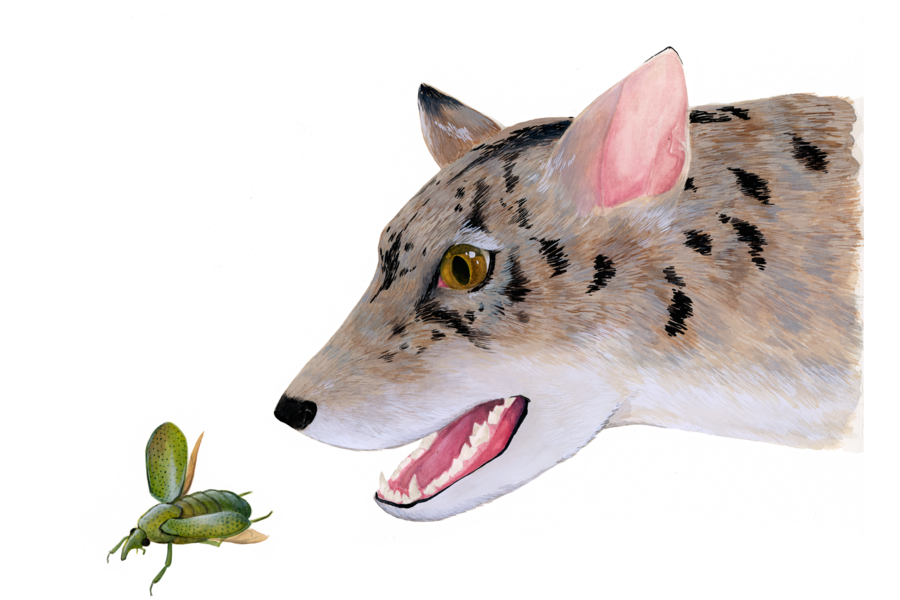What's a beardog? Extinct Chihuahua-sized animal yields clues.
Loading...
To get his bearings as a new postdoctoral researcher at the Field Museum of Natural History in Chicago about three years ago, Susumu Tomiya began going through the museum's archive's drawers and cabinets. That's how he stumbled upon enigmatic jawbones that were about 37 million or 38 million years old.
"It was classified as a sort of a generic, very primitive carnivore," Dr. Tomiya tells The Christian Science Monitor. But "the classification of the animal seemed wrong."
During previous research, Tomiya had examined many carnivoran fossils from the same time period. "The teeth of the jaws reminded me of much larger and later animals, known as beardogs," he says.
So Dr. Tomiya and his colleague, Zhijie Jack Tseng, X-ray CT scanned the fossils to take a closer look. And they found that these little jaw bones were indeed from a Chihuahua-sized beardog.
Their research, reported in a paper published Tuesday in the journal Royal Society Open Science, sheds light on the strange family known as the beardog, or Amphicyonidae.
Although the animals have been extinct for a few million years, "Beardogs represent a very successful group of carnivores that thrived in Europe, Asia, Africa, and North America," Xiaoming Wang, curator and chair of vertebrate paleontology at the Natural History Museum of Los Angeles, who was not part of the research, writes in an email to the Monitor. "In their hey days, they were apex predators at various times."
And now a picture of the animal's origins is beginning to take shape.
Tomiya and Dr. Tseng realized the fossil they were looking at in the Chicago collection looked a lot like another fossil animal found at the same site in Texas. And upon examining both specimens, they realized they had the earliest known beardogs on their hands.
"We knew very little about the origin of beardogs," Tomiya says. "We know their later history pretty well. But we didn't really know where they came from, both in terms of the geography of origin and in relation to other groups of carnivorans."
With both specimens being found in Texas, Tomiya and Tseng suspect beardogs may have first emerged in the southern part of North America – or at least that region was significant to their early evolutionary history.
The specimens were unearthed 70 years ago, but were first described just 30 years ago. Then, they were identified as members of the genus Miacis.
"By putting them in this genus called Miacis, there was an implicit statement that these animals were very primitive carnivores that were somehow related to the living dogs and cats, but we couldn't really tell exactly how," Tomiya says.
And this new research provides the additional evidence needed to clarify that evolutionary relationship, Dr. Wang says.
Tomiya and Tseng found the fossils to sit near the base of the Amphicydonidae lineage, which in turn sits within Caniformia, the family that includes dogs, bears, walruses, raccoons, and weasels.
(Note: That is not to say beardogs are dogs, however, as Tomiya explains, "technically speaking the beardogs are neither bears nor dogs, and they are equally closely related to the dogs as weasels, seals, raccoons, and such." Although the later, more dominant members of the beardog group were quite large and did look remarkably like bears.)
The specimen at the Field Museum had previously been dubbed Miacis australis, so the pair renamed it Angelacrtocyon australis. The other specimen from the same rock formation in Texas had been called Miacis cognitus, but as it too proved to be an early beardog, Tomiya and Tseng renamed it Gustafsonia cognita.
Beardogs are entirely extinct: There are no known modern-day descendants of their lineage. But they witnessed the evolution of many members of the carnivoran families that still live today. Living alongside animals such as dogs, cats, and bears for some 40 million years, they could have competed with, and therefore helped shape the evolution of, these well-known predators, Tomiya suggests.
"We may have had rather different-looking dogs, bears, etc. had the beardogs not existed," he writes in a follow-up email to the Monitor. "We are only beginning to understand what exactly those impacts were (e.g., on the rates of diversification and extinction among co-evolving carnivoran groups), and such an inquiry requires researchers to keep improving the list of past biodiversity by uncovering relationships of extinct organisms as well as documenting new fossil discoveries."
As such, "it was quite fortuitous" to happen upon these early beardog bones already in the Field Museum collection, Tomiya says. And, he adds, it's an important reminder that museum collections are still a treasure-trove for new discoveries, even after having already been described in scientific papers. "The specimens we keep in museums keep enlightening us," he says.








